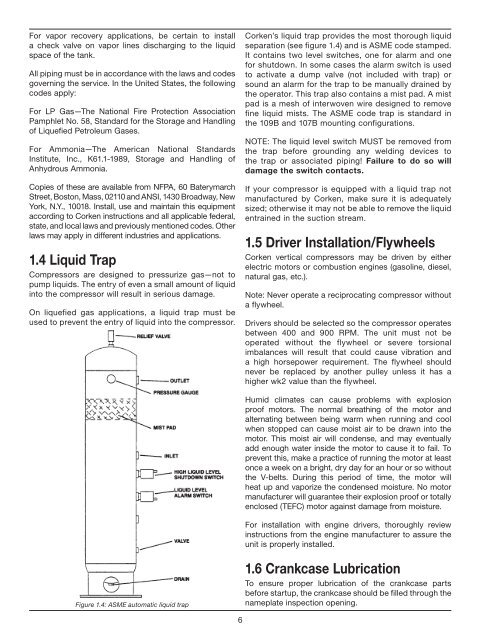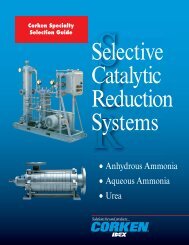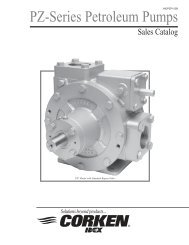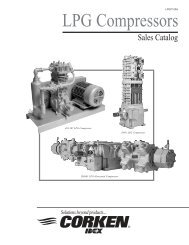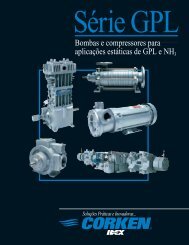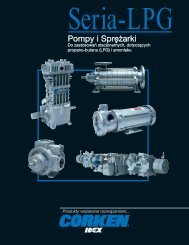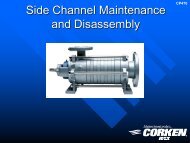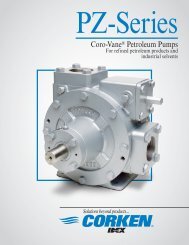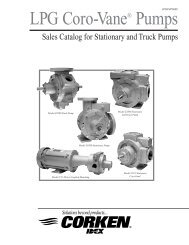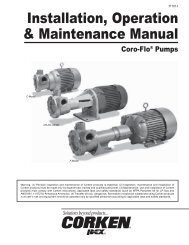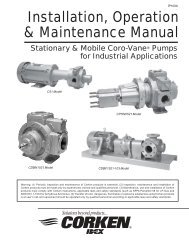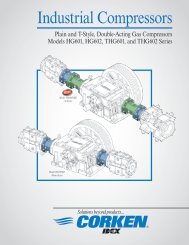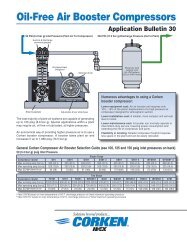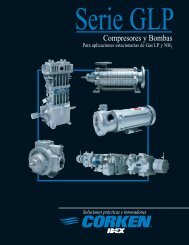Installation, Operation & Maintenance Manual - Corken
Installation, Operation & Maintenance Manual - Corken
Installation, Operation & Maintenance Manual - Corken
Create successful ePaper yourself
Turn your PDF publications into a flip-book with our unique Google optimized e-Paper software.
For vapor recovery applications, be certain to install<br />
a check valve on vapor lines discharging to the liquid<br />
space of the tank.<br />
All piping must be in accordance with the laws and codes<br />
governing the service. In the United States, the following<br />
codes apply:<br />
For LP Gas—The National Fire Protection Association<br />
Pamphlet No. 58, Standard for the Storage and Handling<br />
of Liquefied Petroleum Gases.<br />
For Ammonia—The American National Standards<br />
Institute, Inc., K61.1-1989, Storage and Handling of<br />
Anhydrous Ammonia.<br />
Copies of these are available from NFPA, 60 Baterymarch<br />
Street, Boston, Mass, 02110 and ANSI, 1430 Broadway, New<br />
York, N.Y., 10018. Install, use and maintain this equipment<br />
according to <strong>Corken</strong> instructions and all applicable federal,<br />
state, and local laws and previously mentioned codes. Other<br />
laws may apply in different industries and applications.<br />
1.4 Liquid Trap<br />
Compressors are designed to pressurize gas—not to<br />
pump liquids. The entry of even a small amount of liquid<br />
into the compressor will result in serious damage.<br />
On liquefied gas applications, a liquid trap must be<br />
used to prevent the entry of liquid into the compressor.<br />
<strong>Corken</strong>’s liquid trap provides the most thorough liquid<br />
separation (see figure 1.4) and is ASME code stamped.<br />
It contains two level switches, one for alarm and one<br />
for shutdown. In some cases the alarm switch is used<br />
to activate a dump valve (not included with trap) or<br />
sound an alarm for the trap to be manually drained by<br />
the operator. This trap also contains a mist pad. A mist<br />
pad is a mesh of interwoven wire designed to remove<br />
fine liquid mists. The ASME code trap is standard in<br />
the 109B and 107B mounting configurations.<br />
NOTE: The liquid level switch MUST be removed from<br />
the trap before grounding any welding devices to<br />
the trap or associated piping! Failure to do so will<br />
damage the switch contacts.<br />
If your compressor is equipped with a liquid trap not<br />
manufactured by <strong>Corken</strong>, make sure it is adequately<br />
sized; otherwise it may not be able to remove the liquid<br />
entrained in the suction stream.<br />
1.5 Driver <strong>Installation</strong>/Flywheels<br />
<strong>Corken</strong> vertical compressors may be driven by either<br />
electric motors or combustion engines (gasoline, diesel,<br />
natural gas, etc.).<br />
Note: Never operate a reciprocating compressor without<br />
a flywheel.<br />
Drivers should be selected so the compressor operates<br />
between 400 and 900 RPM. The unit must not be<br />
operated without the flywheel or severe torsional<br />
imbalances will result that could cause vibration and<br />
a high horsepower requirement. The flywheel should<br />
never be replaced by another pulley unless it has a<br />
higher wk2 value than the flywheel.<br />
Humid climates can cause problems with explosion<br />
proof motors. The normal breathing of the motor and<br />
alternating between being warm when running and cool<br />
when stopped can cause moist air to be drawn into the<br />
motor. This moist air will condense, and may eventually<br />
add enough water inside the motor to cause it to fail. To<br />
prevent this, make a practice of running the motor at least<br />
once a week on a bright, dry day for an hour or so without<br />
the V-belts. During this period of time, the motor will<br />
heat up and vaporize the condensed moisture. No motor<br />
manufacturer will guarantee their explosion proof or totally<br />
enclosed (TEFC) motor against damage from moisture.<br />
For installation with engine drivers, thoroughly review<br />
instructions from the engine manufacturer to assure the<br />
unit is properly installed.<br />
Figure 1.4: ASME automatic liquid trap<br />
1.6 Crankcase Lubrication<br />
To ensure proper lubrication of the crankcase parts<br />
before startup, the crankcase should be filled through the<br />
nameplate inspection opening.<br />
6


